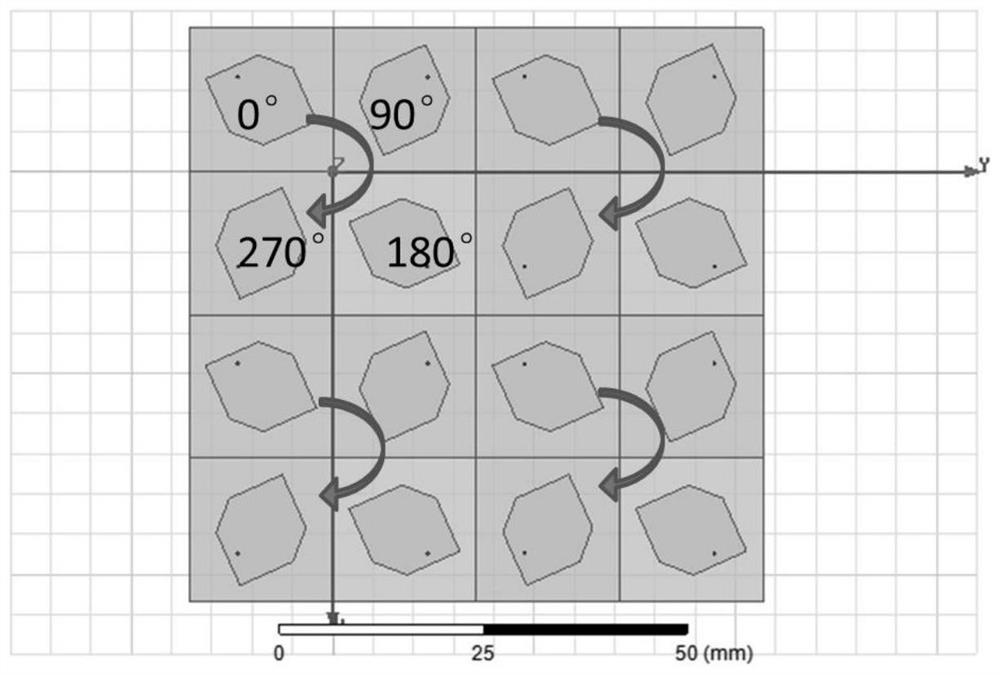Random array antenna pattern synthesis method considering mutual coupling effect
A technology of antenna pattern and random array, applied in special data processing applications, instruments, calculation models, etc., can solve the problems of easy local convergence of traditional particle swarm algorithm, and achieve the effect of overcoming local convergence, improving accuracy, and precise beam design
- Summary
- Abstract
- Description
- Claims
- Application Information
AI Technical Summary
Problems solved by technology
Method used
Image
Examples
Embodiment 1
[0067] Embodiment 1: For a right-handed circularly polarized antenna, a 4×4 X-band right-handed circularly polarized microstrip antenna array is taken as an example to solve the beam synthesis problem of sidelobe suppression. In order to reduce the amount of calculation on the basis of ensuring the comprehensive performance of the array, and the weighted distribution of the amplitude and phase has been determined to be symmetrical about the center of the array based on prior knowledge, we can only consider with Array pattern in two directions. because The sidelobes of the array pattern in the direction are smaller than direction, so one can only consider Array pattern in one direction, the ultimate goal is to achieve sidelobe suppression of 20dB. Such as figure 1 As shown, the specific steps of the antenna pattern synthesis method are as follows:
[0068] Step 1: According to the system application index, determine the microstrip antenna whose center frequency is 8....
Embodiment 2
[0091] Embodiment 2: For a left-handed circularly polarized antenna, a 4×4 K-band left-handed circularly polarized microstrip antenna array is taken as an example to solve the radiation flat-top wide beam synthesis problem. In order to reduce the amount of calculation on the basis of ensuring the comprehensive performance of the array, and the weighted distribution of the amplitude and phase has been determined to be symmetrical about the center of the array based on prior knowledge, we can only consider with The array pattern in two directions satisfies the 3dB beamwidth up to 80°. Such as figure 1 As shown, the specific implementation steps of the antenna pattern synthesis method are as follows:
[0092] Step 1: According to the system application index, determine the microstrip antenna whose center frequency is 14.75GHz, the number of array elements is 4×4, and the array element spacing is 10.5mm. Use the full-wave electromagnetic simulation software HFSS to establish a...
Embodiment 3
[0099] Embodiment 3: For a large-scale linearly polarized array, a 16×16 Ka-band linearly polarized microstrip antenna array is taken as an example to solve the radiation flat-top wide beam synthesis problem. only consider with Array patterns in two directions, the ultimate goal is to achieve a 3dB beamwidth of 50° and a sidelobe level of less than -10dB. Such as figure 1 As shown, the specific implementation steps of the antenna pattern synthesis method are as follows:
[0100] Step 1: According to the system application index, determine the microstrip antenna whose center frequency is 30GHz, the number of array elements is 16×16, and the array element spacing is 5mm. Use the full-wave electromagnetic simulation software HFSS to establish a two-dimensional rectangular array antenna model. Perform full-wave electromagnetic simulations such as Figure 8 shown. For large-scale arrays, quickly extract all active element patterns through HFSS-MATLAB-API;
[0101] Step 2: D...
PUM
 Login to View More
Login to View More Abstract
Description
Claims
Application Information
 Login to View More
Login to View More - R&D
- Intellectual Property
- Life Sciences
- Materials
- Tech Scout
- Unparalleled Data Quality
- Higher Quality Content
- 60% Fewer Hallucinations
Browse by: Latest US Patents, China's latest patents, Technical Efficacy Thesaurus, Application Domain, Technology Topic, Popular Technical Reports.
© 2025 PatSnap. All rights reserved.Legal|Privacy policy|Modern Slavery Act Transparency Statement|Sitemap|About US| Contact US: help@patsnap.com



